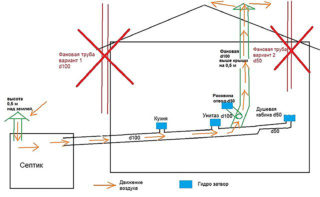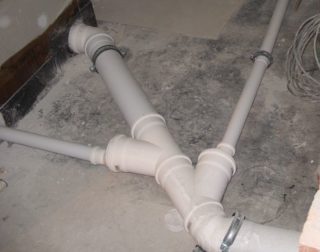If the sewer stench infiltrates your home, don't panic. Not the fact that there is a serious problem in the system. The reasons may be minor. If you find them in time, it will not be difficult to eliminate the disgusting smell of sewage in a private house.
The main causes of sewer odor

In high-rise buildings, fetid miasma can spread due to damage to the common house drainage network. This problem does not concern residents of private houses. But when using autonomous treatment facilities, there is another danger. For example, a sealed septic tank or cesspool is overflowing, and sewage is approaching the inlet pipe. It is not difficult to cope with the trouble - you need to call a sewer truck for pumping out.
If the treatment plant is okay, the odor is likely due to other reasons:
- One of the siphons is dry or clogged. In the first case, the problem with the water seal is caused by the suction of water from it by rarefied air or evaporation due to a long idle time. In the second, the accumulated residues of fat, hair and other organic matter stink.
- Invisible leaks in pipes or at the joints of trunk nodes. Small cracks exude moisture, which fades away and exudes an unpleasant "aroma". Most often, drips are formed due to wear and loss of tightness of gaskets and seals.
- Blockage in the pipeline. It can form in the sewer pipe or in the branches of the sewer network. A problem can be detected by a bad drain.
- The ventilation system is not working well.
All these problems are easy to fix. Worse if the stench is caused by improper installation of the drain pipe. For example, the required slope has not been observed, and sewage stagnates in one of the pipe sections. Too large a bias can also lead to the appearance of a stench. The rapid movement of drains leads to the emptying of the hydraulic seal, and sewage gases freely enter the bathroom through the siphon device.
The emergence of "aromas" is due to the lack of a funnel. When building communications in country houses, this important element is often neglected, and as a result, it is impossible to breathe in the toilet.
How to eliminate sewer odor in a private house
The first steps
Check the condition of the water seals. If you haven't used plumbing fixtures for a long time, just turn on the taps in the bathroom and in the kitchen, flush the toilet tank several times. The water stream will update the state of the closures, and the "fragrances" will disappear in a couple of hours.
If that doesn't work, disassemble the siphons themselves, clean them and replace them. With dirt and mucus, the smell will go away.
Check the washing machine. Fungal and mold growths often develop on the powder and rinse aid tray, sealing elements and near the drain. Connoisseurs of delicate washing are especially at risk, slightly warm water does not harm microorganisms at all. If you find dirty and moldy areas, wash the machine thoroughly with an antibacterial agent.
It is not difficult to identify violations in the ventilation system. Press the piece of paper against the wire rack and remove your hand.If it falls down, there is no air flow. It is required to clean the line. If the cleaning does not work, you need to install new pipes. In order to save money, you can equip forced air cleaning. It will be enough to insert a small fan into the hole.
Search for leaks

If plumbing and household appliances shine clean and function without problems, it may be a matter of microleaks. To find them, carefully check all visible parts of the line, focusing on joints and joints.
Worn and leaking seals can be replaced without problems. But if a crack has arisen in the body of the pipe section, it is dismantled and replaced with a new one, using couplings and fittings. A small crack in the plastic pipe is removed by cold welding. It consists in sealing the breakdown with a special adhesive that firmly connects the plastic elements at the molecular level. Before applying the product, the area should be degreased.
To temporarily eliminate leaks, use compression clamping fittings or "plastering" the hole with cement diluted with water and a pharmacy bandage.
Microleaks that cause stench are not limited to open pipelines. Perhaps the damaged section was hidden behind a frame finish - a plasterboard or plastic panel. They identify the problem by external signs: the coating damp, mold spots form on it. To get to the leak and fix it, the finishing elements are dismantled.
Clearing blockages
- Check how the water drains out in the kitchen. If it’s bad, there’s a blockage from the sink to the bathroom.
- If the drain is weak in the washbasin and bathtub, the plug is located in the area from the sink to the toilet.
- If only the toilet is up, there is a blockage in the outlet pipe.
Cleaning is carried out, starting from the extreme plumbing fixture, where there is no drainage of the liquid. Small blockages are removed with a plunger. If it does not work, they usually use a plumbing cable.

If you do not want to mess with mechanical cleaning methods, you can use chemical agents. They are of two types - acid-based and alkali-based. The first ones are used to dissolve organic matter without greasy inclusions. Acidic formulations get rid of hair plugs in sink and bath drains. Alkaline reagents break down fatty compounds. They are used to eliminate blockages in the kitchen sink.
Large blockages that do not lend themselves to home cleaning are removed by hydrodynamics. A special apparatus breaks through the plug with a high pressure water jet.
If you have a home car wash device, you can do the cleaning yourself. If not, you will need professional help.
A small blockage is also eliminated using folk methods. To do this, use table salt, baking soda with vinegar, or caustic soda. The compositions are poured into the drain hole and poured with an abundant amount of water. Salt and soda "baths", if done regularly, help get rid of the nasty smell of sewage in a private house, even if the pipes are not clogged, but only covered with sewage from the inside. Do not overdo it with the amount of drugs, two tablespoons are enough.
Design problems
If there is no fan pipe, it should be installed. A vertical riser is brought out directly to the roof of the house. If you bring it only to the attic, this will not give the necessary traction, and it will not work to remove the nasty smell of the sewer. Above a pitched roof, the pipe should rise by half a meter, above a flat roof by 30 cm.The riser is connected to the sewer line through a ventilation valve mounted in the bell. It may be necessary to cut in a sleeve with an additional hole for this.
Worst of all, the stench arises from the wrong slope of the pipeline. Here it remains only to dismantle the sewer and install it again.
Preventive measures

In order to avoid blockages and the formation of internal plaque in the pipes, from time to time carry out preventive measures:
- Pour 10 liters of an aqueous solution of household chemicals into the drain holes twice a month, or use folk remedies.
- Clean the siphon devices every 30 days.
- Perform preventive pipeline inspections for leaks.
- Once every six months, clean with a potent compound - specialized or caustic soda.
- Wash the washing machine regularly, run it every two months without any clothes at the maximum temperature setting.
Make sure that the odor trap does not disappear. If you are leaving, fill the seal with machine oil. It evaporates for a long time and prevents drying.
In most cases, it is not difficult to get rid of the stench from the sewer. The main thing is to quickly find the cause of its occurrence.










